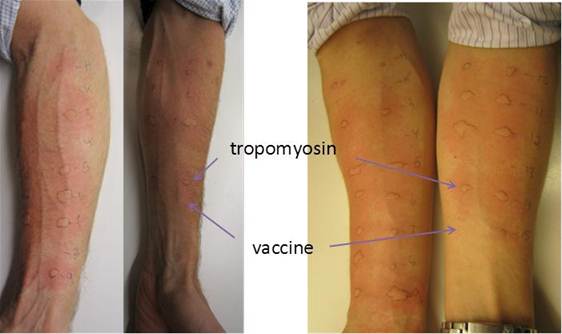The prevalence of allergies has grown into an epidemic, affecting hundreds of millions of people, particularly children. The socio-economic impact is immense and current therapies are primarily based on symptomatic relief. We have developed a concept for a novel type of vaccine for the treatment of food allergic diseases, ALLERVACC.

Candidate vaccine – A schematic representation of the molecular structure of candidate vaccine against shrimp allergy. The shrimp allergen tropomyosin is linked to a ligand that inhibits the inflammatory response to the allergen.
ALLERVACC is a fusion protein consisting of an allergen of choice bound to a ligand that induces immunological tolerance. Here, the allergen will drive the vaccine to the cells that need to be suppressed in food allergy, while the ligand will induce tolerance by anergy or apoptosis in these cells. Overall, this induces immunological tolerance to the allergen. Using a shrimp allergen as a model, we have shown that the vaccine is capable of inhibiting allergic responses in several in vitro tests with both human and mouse cells, and in human skin prick test in shrimp allergic persons.

Skin Prick Test – The candidate vaccine was tested with a skin prick test on two shrimp allergic patients. The wheal on the skin shows that tropomyosin induces a positive response, while the vaccine does not. This indicates that the presence of the ligand in the vaccine reduces the allergic responses to the allergen tropomyosin.
The main objective of this project is to generate an IPR-secured ALLERVACC for the treatment of IgE-mediated food allergies. The main challenges of the project are (i) further improvement of the stability of ALLERVACC in physiological solutions, (ii) generation and testing of ALLERVACC against peanut allergy and (iii) set-up of a strategy for the proof of concept vaccination studies in humans via animal-studies. The experiments will be made possible by our project partners Oslo University Hospital (clinical studies), and the Norwegian Institute of Public Health (animal studies).